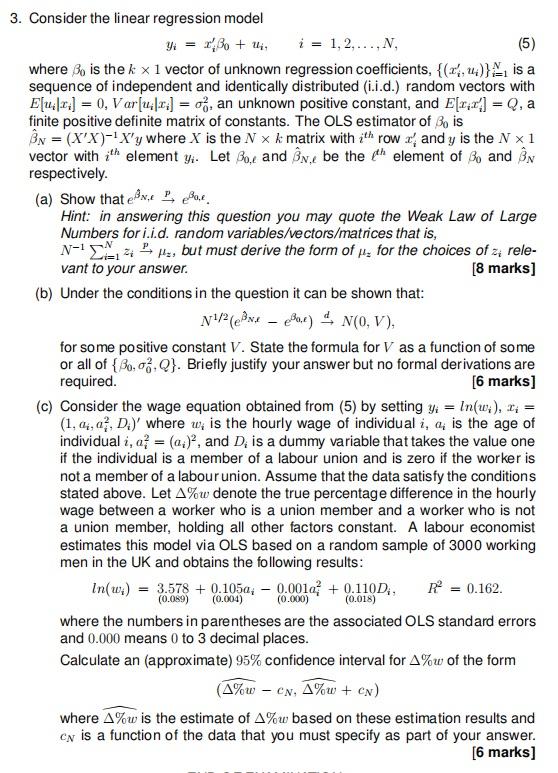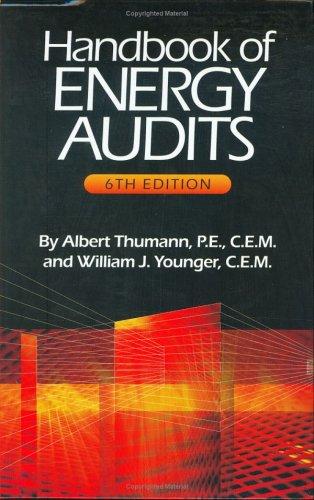
3. Consider the linear regression model yi=xi0+ui,i=1,2,,N, where 0 is the k1 vector of unknown regression coefficients, {(xi,ui)}i=1N is a sequence of independent and identically distributed (i.i.d.) random vectors with E[uixi]=0,Var[uixi]=02, an unknown positive constant, and E[xixi]=Q, a finite positive definite matrix of constants. The OLS estimator of 0 is ^N=(XX)1Xy where X is the Nk matrix with ith row xi and y is the N1 vector with ith element yi. Let 0, and ^N, be the th element of 0 and ^N respectively. (a) Show that e^N,pe0,. Hint: in answering this question you may quote the Weak Law of Large Numbers for i.i.d. random variables/vectors/matrices that is, N1i=1Nzipz, but must derive the form of z for the choices of zi relevant to your answer. [8 marks] (b) Under the conditions in the question it can be shown that: N1/2(e^N,e0,)dN(0,V), for some positive constant V. State the formula for V as a function of some or all of {0,02,Q}. Briefly justify your answer but no formal derivations are required. [6 marks] (c) Consider the wage equation obtained from (5) by setting yi=ln(wi),xi= (1,ai,ai2,Di) where wi is the hourly wage of individual i,ai is the age of individual i,ai2=(ai)2, and Di is a dummy variable that takes the value one if the individual is a member of a labour union and is zero if the worker is not a member of a labour union. Assume that the data satisfy the conditions stated above. Let %w denote the true percentage difference in the hourly wage between a worker who is a union member and a worker who is not a union member, holding all other factors constant. A labour economist estimates this model via OLS based on a random sample of 3000 working men in the UK and obtains the following results: ln(wi)=(0.069)3.578+(0.004)0.105ai(0.000)0.001ai2+(0.018)0.110Di,R2=0.162. where the numbers in parentheses are the associated OLS standard errors and 0.000 means 0 to 3 decimal places. Calculate an (approximate) 95% confidence interval for %w of the form (%wcN,%w+cN) where %w is the estimate of %w based on these estimation results and cN is a function of the data that you must specify as part of your answer. [6 marks] 3. Consider the linear regression model yi=xi0+ui,i=1,2,,N, where 0 is the k1 vector of unknown regression coefficients, {(xi,ui)}i=1N is a sequence of independent and identically distributed (i.i.d.) random vectors with E[uixi]=0,Var[uixi]=02, an unknown positive constant, and E[xixi]=Q, a finite positive definite matrix of constants. The OLS estimator of 0 is ^N=(XX)1Xy where X is the Nk matrix with ith row xi and y is the N1 vector with ith element yi. Let 0, and ^N, be the th element of 0 and ^N respectively. (a) Show that e^N,pe0,. Hint: in answering this question you may quote the Weak Law of Large Numbers for i.i.d. random variables/vectors/matrices that is, N1i=1Nzipz, but must derive the form of z for the choices of zi relevant to your answer. [8 marks] (b) Under the conditions in the question it can be shown that: N1/2(e^N,e0,)dN(0,V), for some positive constant V. State the formula for V as a function of some or all of {0,02,Q}. Briefly justify your answer but no formal derivations are required. [6 marks] (c) Consider the wage equation obtained from (5) by setting yi=ln(wi),xi= (1,ai,ai2,Di) where wi is the hourly wage of individual i,ai is the age of individual i,ai2=(ai)2, and Di is a dummy variable that takes the value one if the individual is a member of a labour union and is zero if the worker is not a member of a labour union. Assume that the data satisfy the conditions stated above. Let %w denote the true percentage difference in the hourly wage between a worker who is a union member and a worker who is not a union member, holding all other factors constant. A labour economist estimates this model via OLS based on a random sample of 3000 working men in the UK and obtains the following results: ln(wi)=(0.069)3.578+(0.004)0.105ai(0.000)0.001ai2+(0.018)0.110Di,R2=0.162. where the numbers in parentheses are the associated OLS standard errors and 0.000 means 0 to 3 decimal places. Calculate an (approximate) 95% confidence interval for %w of the form (%wcN,%w+cN) where %w is the estimate of %w based on these estimation results and cN is a function of the data that you must specify as part of your answer. [6 marks]







